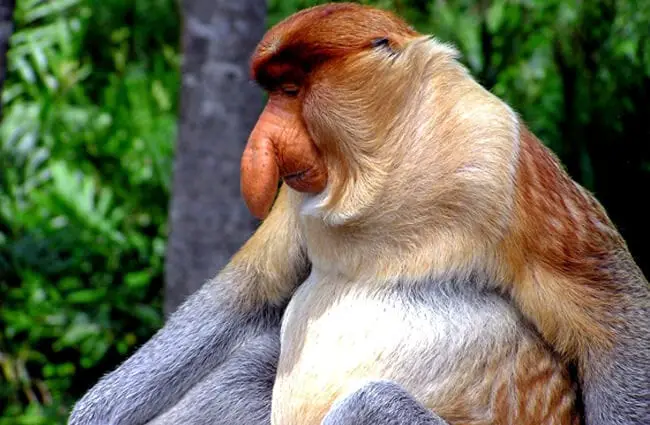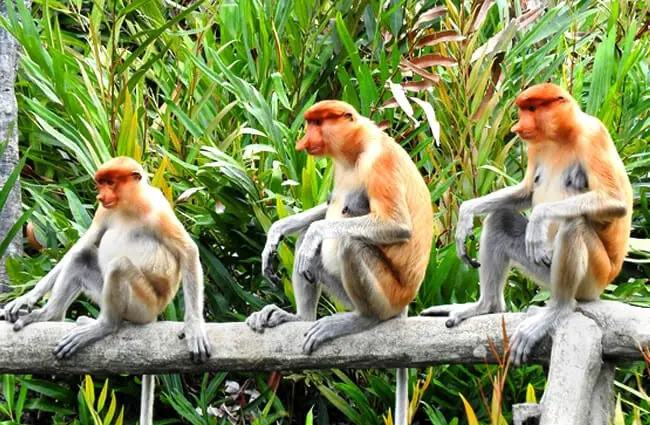A Deep Dive into the World of the Proboscis Monkey
The Proboscis Monkey, Nasalis larvatus, is arguably one of the most unusual and captivating primates on Earth. Instantly recognizable by the extraordinarily large nose of the mature male, this arboreal mammal is endemic to the Southeast Asian island of Borneo. More than just a peculiar feature, the nose plays a significant role in the monkey’s biology and social life. This guide provides a comprehensive overview of the Proboscis Monkey, covering its habitat, behavior, evolution, conservation status, and everything in between.

Habitat and Distribution
Proboscis Monkeys are strictly confined to the lowland forests and mangrove swamps of the island of Borneo, shared by Malaysia, Indonesia, and Brunei. They demonstrate a strong preference for areas close to rivers, lakes, and the sea. These habitats offer abundant fruit, leaves, and insects that form the bulk of their diet. They are also adept swimmers, often crossing bodies of water to reach feeding grounds. While historically widespread across Borneo, their populations are now fragmented due to habitat loss and degradation. The monkeys are typically found in groups along rivers and in swampy forests, relying on these waterways for both food and transportation.
Physical Characteristics
Beyond the prominent nose, Proboscis Monkeys possess several other distinguishing features. They have reddish‑brown fur, long limbs, and partially webbed feet that aid in swimming. Adult males weigh between 11 and 20 kilograms, while females are considerably smaller, averaging between 7 and 12 kilograms. The large nose of the male is thought to be a secondary sexual characteristic used to attract females. The larger the nose, the more attractive the male is considered to be, and it also potentially amplifies his vocalizations. Interestingly, juveniles have small, upturned noses that gradually grow larger as the male matures.

Diet and Feeding Behavior
Proboscis Monkeys are primarily frugivores, meaning their diet consists largely of fruit. However, they are opportunistic feeders and also consume leaves, insects, seeds, and even small vertebrates. They have a complex, multi‑chambered stomach containing bacteria that help them digest tough leaves. Their diet varies seasonally, depending on the availability of different food sources. They exhibit a preference for young, tender leaves and fruit, but will also consume mangrove buds and algae when other options are scarce. They are often seen carefully selecting their food, rejecting anything that appears damaged or unpalatable.
Social Structure and Behavior
Proboscis Monkeys live in multiple male, multiple female groups, typically consisting of one dominant male, several subordinate males, and numerous females with their offspring. The dominant male maintains his position through displays of aggression and vocalizations. Subordinate males often form alliances to challenge the dominant male, leading to intense competition for reproductive rights. Groups often travel along rivers, foraging for food and seeking shelter. They communicate through a variety of vocalizations, including honks, screams, and grunts. Males also use visual displays, such as nose rubbing and branch shaking, to assert their dominance.

Reproduction and Life Cycle
The mating season for Proboscis Monkeys typically occurs between February and June. The dominant male has exclusive access to the females in his group. Gestation lasts around 205 to 235 days, resulting in the birth of a single infant. Infants are completely dependent on their mothers for the first several months of life, clinging to their fur and nursing frequently. They gradually learn to forage for food and explore their surroundings. Juvenile monkeys reach sexual maturity at around 5 to 7 years of age. Females typically give birth to an infant every two years.
Evolutionary History
The evolutionary history of the Proboscis Monkey is still being investigated, but it is believed that they diverged from other Old World monkeys several million years ago. Their unique adaptations, such as the large nose and webbed feet, are thought to have evolved in response to the specific environmental conditions of Borneo. The large nose may have initially evolved as a signal of male quality, attracting females and enhancing reproductive success. The webbed feet likely developed as an adaptation to their semi aquatic lifestyle, allowing them to swim more efficiently. Genetic studies are ongoing to further clarify their evolutionary relationships with other primate species.

Ecological Role and Interactions
Proboscis Monkeys play an important role in their ecosystem. As frugivores, they contribute to seed dispersal, helping to maintain the health and diversity of the forest. They also serve as prey for larger predators, such as crocodiles and clouded leopards. They frequently interact with other primate species, such as macaques and orangutans, often competing for food resources. These interactions can influence the distribution and abundance of different species. They also benefit certain plant species by pruning vegetation and creating gaps in the canopy, allowing sunlight to reach the forest floor.
Conservation Status and Threats
The Proboscis Monkey is currently classified as Endangered by the International Union for Conservation of Nature (IUCN). Their population is estimated to be around 26,000 individuals, and it continues to decline due to habitat loss, fragmentation, and hunting. The conversion of mangrove forests and peat swamps into oil palm plantations and other agricultural land is the primary threat to their survival. Hunting for bushmeat and traditional medicine also poses a significant risk. Conservation efforts include habitat protection, anti‑poaching patrols, and community‑based conservation programs.
Human‑Monkey Interactions
Human activities have had a significant impact on Proboscis Monkey populations. Habitat loss and fragmentation are the most pressing threats, but conflict with humans also occurs. Monkeys may raid crops, leading to retaliatory killings. Tourism can also have both positive and negative effects. While ecotourism can generate revenue for conservation efforts, it can also disrupt monkey behavior and increase stress levels. Responsible ecotourism practices, such as maintaining a safe distance and avoiding feeding the monkeys, are essential.

Proboscis Monkey Care in Captivity
Caring for Proboscis Monkeys in captivity requires a specialized understanding of their unique needs. Enclosures must be large and complex, providing ample space for climbing, foraging, and social interaction. Diet should consist of a variety of fruits, leaves, and insects, mimicking their natural diet. Enrichment activities, such as puzzle feeders and climbing structures, are essential to prevent boredom and promote mental stimulation. Monitoring for signs of stress or illness is crucial. Providing access to water for swimming and bathing is also important. A dedicated veterinary team with experience in primate care is necessary to ensure their health and well‑being.
Fascinating Facts About Proboscis Monkeys
- The Proboscis Monkey is a skilled swimmer and can cross rivers up to 20 meters wide.
- They have a special adaptation in their nostrils that allows them to close their noses underwater.
- Their large nose is not filled with bone but is mostly cartilage and skin.
- Males use their noses to amplify their vocalizations, creating a loud honking sound.
- Proboscis Monkeys often engage in allogrooming, a social behavior where they groom each other’s fur.
- They are diurnal, meaning they are active during the day and sleep at night.
- They can live for up to 20 years in the wild.
The Proboscis Monkey is a remarkable primate that embodies the unique biodiversity of Borneo. Understanding their biology, behavior, and conservation status is essential for ensuring their survival in the face of growing threats. Through ongoing research, habitat protection, and community involvement, we can secure a future for this iconic species.

![Red Angus Closeup of a beautiful Red Angus cowPhoto by: U.S. Department of Agriculture [pubic domain]https://creativecommons.org/licenses/by/2.0/](https://animals.net/wp-content/uploads/2020/03/Red-Angus-4-238x178.jpg)




![Red Angus Closeup of a beautiful Red Angus cowPhoto by: U.S. Department of Agriculture [pubic domain]https://creativecommons.org/licenses/by/2.0/](https://animals.net/wp-content/uploads/2020/03/Red-Angus-4-100x75.jpg)

